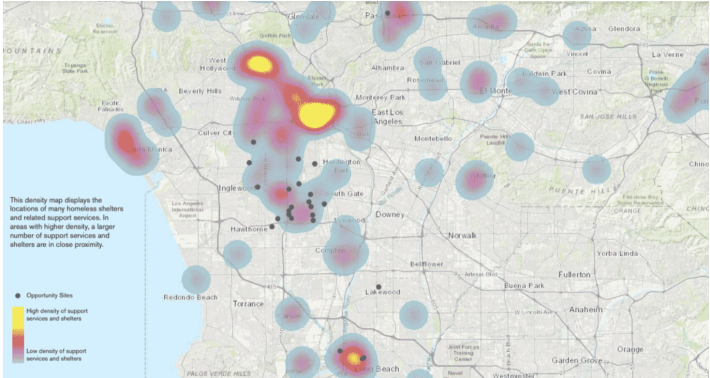As membership numbers of congregations across the nation drop, religious leaders are not only looking for new ways to increase those numbers but reexamining their role—and locally, the Los Angeles Clergy Development Council feels the church could change the housing discussion.
Collaborating with the Long Beach firm Studio One Eleven, the unexpected partnership is examining hundreds of church properties throughout the county and looking into how these properties could act as bridge housing for the homeless.
Bridge housing—temporary shelter and housing that is used to help those experiencing homelessness while they wait to obtain Section 8 vouchers or, should they already have a housing voucher, waiting for placement—is not only one of the most important steps in achieving permanent housing for those experiencing homelessness, it is difficult to acquire and maintain.
The full brunt of bridge housing is placed on select shelters and nonprofits, like Long Beach’s Multi-Service Center, which provide beds—and those beds aren’t always guaranteed.
In my correspondence with a blind senior by the name of Tyletha, on the streets of Long Beach for many years, it took multiple years to get her off the street and into permanent housing.
“Tyletha was traumatized on the streets and we would find her coming to the Multi-Service Center highly agitated,” Lucinda Hayes, an Outreach Coordinator for the City of Long Beach, said. “She would scream, she would yell—and for one whole year, an entire year, she had to go through the process of being an emotional wreck; we all had to go through the process of assuring that she was ready to stabilize her mental health and life.”
In other words, when it comes to bridge housing, there is a period where mental and physical health have to be assured before moving forward and even after that is achieved, housing isn’t guaranteed. It took Tyletha one year to become mentally stable and another year before she stepped inside a home she could call her own.
Bridge housing was what kept this process possible.
Studio One Eleven and these churches understand that, with the architectural firm (for now) examining 24 potential properties out of over 300.
“We’re trying to examine all aspects,” said Michael Bohn, principal at Studio One Eleven. “For example, there are four or five locations that aren’t within walking distance of public transit—so we find out if they have big parking lots. If they do, we note that perhaps this is where those who are experiencing homeless but have vehicles should be placed. They are provided a safe, protected haven with their vehicle and are not competing with those who heavily depend on transit.”

This includes examining not just proximity to transit but also proximity to other services to strengthen partnerships between the participating churches and existing service experts, finding locations near student populations to help the increasing homeless population among youth, and proximity to art and cultural institutions that can provide both leisure and assistance.
Of course, there are complexities and hurdles that make this project difficult to execute.
At one point, the team had scored a handful of portable classrooms—easy to move, east to attach to power, and stable—but once the man who had donated them had his attorney involved, questions about liability arose leaving the possibility of using them, in the words of Bohn, “in purgatory.”
“The churches fought back, asking for just the chassis and we’ll construct the rest or, ‘Make us sign a waiver,’ but when attorneys get involved, it’s never fun,” Bohn said.
There are, however, silver linings that come with breaking down specific properties. One of those “good news” things, as Bohn puts it, is a particular space in Long Beach at 1833 Harbor Ave. in West Long Beach, home to the Good News Church of God in Christ.
It has two large parking lots—one at 3,000 square feet and another at over 10,000 square feet. And it’s within a mile of the Long Beach Rescue Mission (which provides food, shelter, clothing, counsel, spiritually based rehabilitation, and transitional housing), Christian Outreach in Action (which provides transitional housing and support services), and the Long Beach Career Corps Center (which provides no-cost education and a career center for young people ages 16 through 24).
Its nearest bus station is about a half-mile away and its nearest rail station is 1.24 miles away, meaning it’s a place recommended for those with vehicles and at-risk youth populations given the potential partnership with the Corps Center.
“On top of this, there is a women’s shelter and service provider nearby,” Bohn said. “This combined with the Corps Center’s proximity makes this area prime for women experiencing homelessness or single mothers experiencing homelessness. In other words, let’s get the users close to the services and amenities they need.”
The project will continue moving forward until all 300-plus sites have been thoroughly examined, with recommendations as to how to move forward handed off to each church by Studio One Eleven itself.
Brian Addison is a columnist and editor for the Long Beach Post. Reach him at brian@lbpost.comor on social media at Facebook, Twitter, Instagram, and LinkedIn. This post originally appeared on the LongBeachize page at the Post. LongBeachize is a joint project of the Post and Southern California Streets Initiative, which also publishes Streetsblog Los Angeles.







